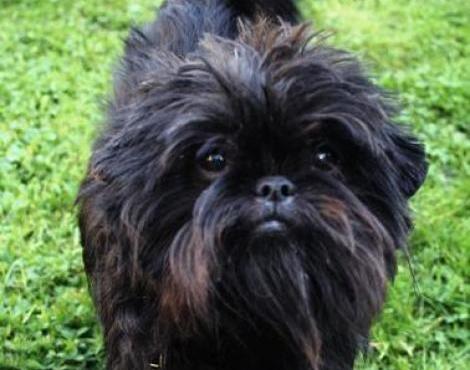Affenpinscher History and Domestication
The Affenpinscher is thought to be one of the oldest toy Dog breeds, appearing in Germany during the 17th century. Although the Affenpinscher then was bigger than the Dog we know today, it is thought that the ancestors of these Dogs were around much earlier, being depicted in paintings as early as the 15th century. The Affenpinscher was first bred and kept as a form of pest control in kitchens and stables, as these active Terriers proved effective at keeping rat numbers down. By the late 1800s, the breed was fully established in southern Germany and was a favoured Dog of the rich and famous. The Affenpinscher was imported in the USA after the second world war, where today, more Affenpinschers exist than anywhere else in the world combined.
Affenpinscher Physical Characteristics
Affenpinschers have a distinctive appearance that is often associated with terriers. The small body of the Affenpinscher is covered in coarse, wiry fur that tends to be either black or grey in colour, and is actually quite long for such a small Dog. The head of the Affenpinscher is domed, with a short muzzle, small ears and dark eyes and it’s trade-mark “monkey like” expression is exaggerated by it’s protruding lower lip. Their tails are relatively short. Historically, the tail of the Affenpinscher would have been docked, and ancestors of the breed today were found in variety of colours including red, fawn and beige and would have been larger in size.
Affenpinscher Behaviour and Temperament
Despite it’s distinctive Terrier-like appearance, the Affenpinscher is different from other Terriers, as they are actually part of the pinscher-schnauzer subgroup. These characteristics mean that not only is the Affenpinscher small, active and loyal but they also often get along well with other Dogs and pets. Some of the most distinctive traits of the Affenpinscher are that they are active, adventurous, curious, and stubborn, but they are also fun-loving and playful. The breed is confident, lively and affectionate towards family members, but their loyalty towards them also makes them very protective of them. Affenpinschers can be somewhat territorial when it comes to their toys and food, so they are not recommended for households with very small children. This Dog is generally quiet but can become very agitated if it feels under threat, showing no fear toward any aggressor.
Affenpinscher Breeding
The Affenpinscher breed that we know today was first bred in Germany in the late 17th century as a household ratter. These Dogs would have been at least 30cm tall (some believe them to be ever larger) making them significantly bigger than the Dog of today. Inter-breeding with other domestic breeds during the early 1900s gave rise to the smaller sized and flatter-faced Affenpinscher that was imported into America a number of decades later. Despite there being a number of this breed in the USA, the Affenpinscher has never really become a popular Dog choice in Britain, with their being less than 30 breeders in the country today. On average, Affenpinschers produce only a few puppies per litter, which are blind when first born.
Affenpinscher Interesting Facts and Features
The Affenpinscher was first named in 17th century Germany as Zwergaffenpinscher which literally translated means little-monkey-dog, due to it’s curious Monkey-like expression. However, when Affenpinscher numbers were in demise during the war, the Dog was bred with other small breeds including the Brussels Griffon, leading to the desired breed of today. Curiously, the Affenpinscher had been used years before in the creation of the Brussels Griffon, which when re-bred with the Affenpinscher, led to a shorter muzzle and more prominent chin. As with nearly every breed of domestic Dog, there a number of health problems associated with the Affenpinscher. The most common ailments are caused by such an inquisitive and active nature, often leading to a number of cuts and bumps along with broken bones.





